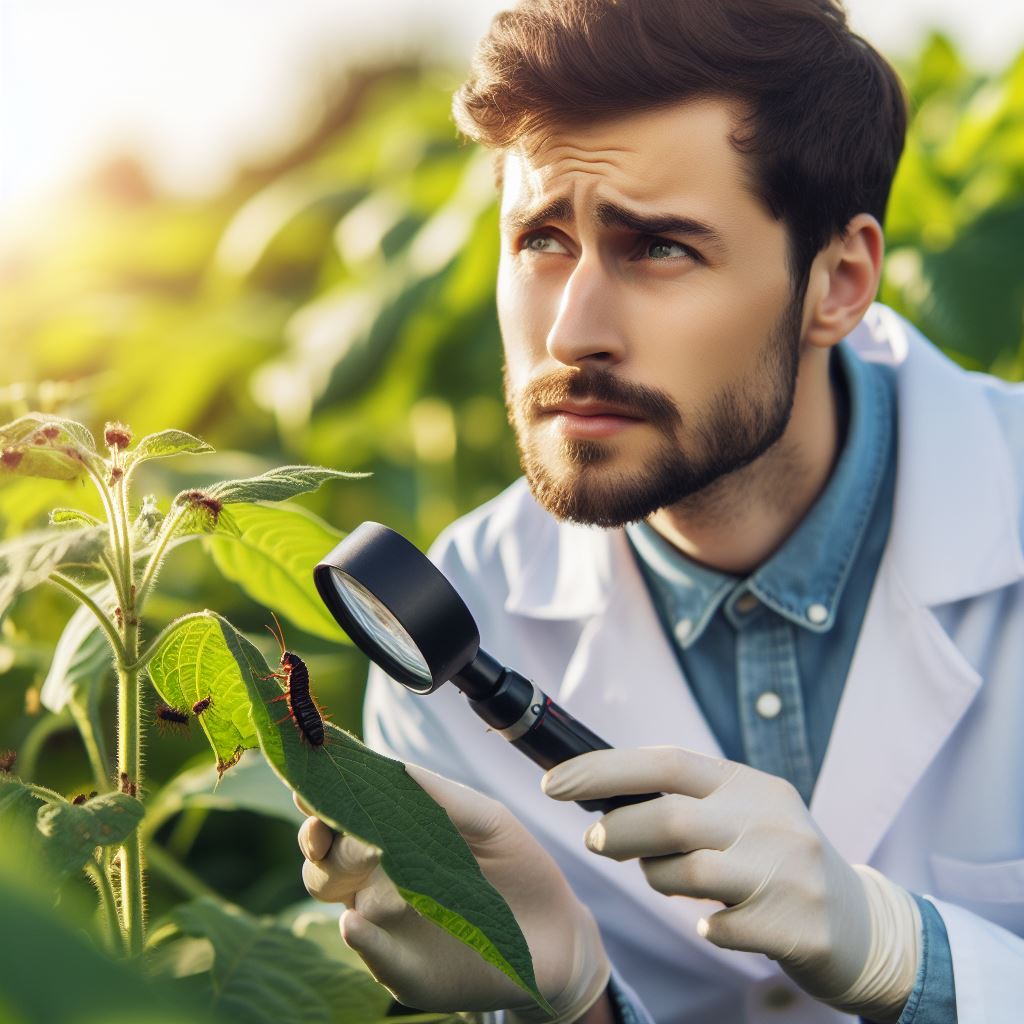Tech Advances in IPM for Sustainability
Last Updated on January 23, 2024
Introduction
Integrated Pest Management (IPM) is a sustainable approach to managing pests in agriculture.
It combines different methods such as biological control, cultural practices, and the judicious use of pesticides to minimize the impact on the environment and human health.
Over the years, the use of technology in IPM has been steadily increasing.
From drones and remote sensing to data analytics and artificial intelligence, farmers now have access to innovative tools that can revolutionize pest management practices.
In this blog post, we will delve into the recent technological advances in IPM that aim to enhance sustainability in farming.
These advancements have the potential to revolutionize the way pests are managed, offering more efficient, precise, and eco-friendly solutions.
As we explore these tech advances, we will highlight their benefits, challenges, and potential implications for sustainable agriculture.
By the end of this blog post, readers will have a clear understanding of how technology is shaping IPM practices and contributing to the overall sustainability of farming systems.
With constant innovation and the adoption of new technologies, IPM continues to evolve, offering farmers more effective and sustainable approaches to pest management.
The integration of technology into IPM not only enhances efficiency but also has the potential to reduce the dependency on chemical pesticides, minimize environmental impacts, and safeguard ecosystem health.
In the next sections of this blog post, we will dive deeper into specific technological advancements, discussing their applications, impact, and future potential in driving sustainable pest management practices.
Stay tuned to discover how these tech advances are revolutionizing IPM and ensuring a more sustainable future for farming.
IPM and Sustainable Agriculture
Define IPM and its key principles
Integrated Pest Management (IPM) is an approach that utilizes multiple strategies to effectively manage pests.
The key principles of IPM include monitoring pests, identifying thresholds, employing preventive measures, and using control methods.
The underlying objective is to achieve sustainable agriculture, where crop production is economically viable, environmentally friendly, and socially responsible.
The role of IPM in promoting sustainable farming practices
IPM focuses on preventive measures rather than solely relying on reactive pest control methods.
The proactive approach involves regular monitoring of pest populations using scouting techniques or automated systems.
By closely monitoring pest levels, farmers can determine appropriate action thresholds for intervention.
This approach prevents unnecessary treatments and ensures that control measures are only employed when necessary, minimizing pesticide usage.
In addition to preventive measures, IPM emphasizes the use of biological control methods and cultural practices to manage pests.
Biological control involves using natural enemies, such as predators, parasites, or pathogens, to suppress pest populations.
This method promotes the conservation of beneficial organisms and reduces reliance on chemical pesticides.
Cultural practices, such as crop rotation or intercropping, can disrupt pest lifecycles and create less favorable environments for pests, thus reducing their populations.
The need for continuous advancements in IPM
Continuous advancements in IPM are necessary to tackle emerging challenges in pest management.
Pests have the ability to adapt and evolve resistance to conventional control methods, making it essential to develop innovative strategies.
Integrated pest management needs to keep pace with changing pest dynamics and technological advancements in agriculture.
Technological tools, such as remote sensing and data analysis, can enhance the monitoring and prediction of pest outbreaks, enabling timely interventions.
Precision agriculture techniques, such as site-specific application of inputs based on pest distribution maps, can minimize the use of pesticides, leading to more sustainable practices.
Furthermore, understanding the biology, genetics, and behavior of pests is essential for developing effective IPM strategies.
Research on pest ecology and physiology can provide valuable insights into their vulnerabilities, enabling targeted management approaches. Genetic analysis can identify resistance mechanisms, guiding the development of new control options.
Collaboration between researchers, farmers, and policymakers is crucial for implementing advancements in IPM.
Sharing knowledge, best practices, and experiences can accelerate the adoption of sustainable pest management strategies.
Policymakers play a vital role in creating supportive regulations and incentive programs to encourage IPM adoption among farmers.
In fact, IPM is a fundamental approach for achieving sustainable agriculture.
By integrating various pest management techniques, IPM minimizes environmental impact and promotes long-term crop productivity.
Continuous advancements in IPM are necessary to address evolving pest pressures and technological opportunities.
Implementing IPM practices requires collaboration among stakeholders to ensure the adoption of sustainable pest management strategies.
Read: Natural Predators: Allies in IPM
Traditional IPM Approaches
Conventional methods used in IPM
- Chemical pesticides were commonly employed for pest control.
- Biological control agents like predators and parasites were introduced into the ecosystem.
- Cultural practices such as crop rotation and habitat diversification were implemented.
Limitations and challenges associated with traditional IPM approaches
- Overreliance on chemical pesticides resulted in environmental pollution and pesticide resistance.
- Biological control agents often had limited effectiveness and faced issues of non-target impacts.
- Cultural practices required extensive knowledge and were labor-intensive.
The need for innovation and technological integration in IPM
- Advancements in technology can address the challenges of traditional IPM approaches.
- Developing integrated pest management (IPM) programs incorporating new technologies is essential.
- Remote sensing techniques allow for early detection and monitoring of pest populations.
The use of drones equipped with cameras and sensors can provide real-time data for IPM decisions.
Artificial intelligence and machine learning algorithms can analyze vast amounts of data for pest predictions.
Precision agriculture tools, like GPS and GIS, enable targeted application of control measures.
Biopesticides derived from natural sources offer eco-friendly alternatives to chemical pesticides.
Biotechnology enables the development of genetically modified crops with resistance to pests.
Pheromone traps and lures attract pests, reducing the need for broad-spectrum pesticides.
Biocontrol agents, like nematodes and fungi, have shown promise in controlling insect populations.
Smart irrigation systems ensure optimal water use, reducing conditions suitable for pest development.
Crop health monitoring systems detect stress and diseases, prompting early intervention.
In short, traditional IPM approaches have limitations, emphasizing the need for innovation and technological integration.
Implementing advanced technologies and techniques can lead to sustainable pest management practices.
By embracing these advancements, we can reduce environmental impacts while ensuring food security.
Read: IPM: A Farmer Guide to Eco-Farming
Technological Advances in IPM
Role and Impact of Remote Sensing Technologies
Technological advancements have revolutionized Integrated Pest Management (IPM) strategies, making it more sustainable and efficient.
Remote sensing technologies, including the use of drones and satellite imagery, have played a significant role in pest detection and monitoring.
Drones equipped with high-resolution cameras and sensors can capture imagery of large agricultural areas.
This imagery can be analyzed to identify potential pest infestations and monitor their spread.
Satellite imagery with high spatial resolution also provides valuable insights into pest activity and helps farmers take timely intervention measures.
Real-time data collection and analysis have become essential for effective IPM.
With the availability of advanced sensors and monitoring systems, farmers can collect data on various parameters like weather conditions, pest populations, and crop health.
This real-time data allows them to make informed decisions and implement targeted interventions, reducing the need for excessive pesticide use.
Emergence of Precision Agriculture Techniques
Precision agriculture techniques have also emerged as a game-changer in IPM.
The use of GPS systems, GIS, and mapping tools allows farmers to accurately identify and target pest hotspots.
By customizing pesticide application based on precise pest distribution, farmers can minimize chemical usage while maximizing efficacy.
Precision application of pesticides not only reduces environmental impact but also improves cost-effectiveness.
By using technology to apply the right amount of pesticide to the right place, farmers can avoid wastage and prevent negative impacts on beneficial organisms and ecosystems.
Development of Smart Farming Devices and Sensors
The development of smart farming devices and sensors has further enhanced IPM practices.
Internet of Things (IoT) and Artificial Intelligence (AI) are being utilized for early detection of pests.
Automated sensor systems can monitor pest activity and trigger alerts when pest populations exceed certain thresholds.
This proactive approach enables farmers to take timely action, preventing the escalation of pest problems.
Smart farming devices also enable better decision-making by providing real-time data and analytics.
These devices can collect and analyze data on various factors such as temperature, humidity, soil moisture, and pest activity.
By integrating this data with advanced algorithms, farmers can make informed choices about pest management strategies, ensuring optimal crop health and yield.
In essence, technological advances have revolutionized IPM for sustainability.
Remote sensing technologies, precision agriculture techniques, and smart farming devices have significantly improved pest detection, monitoring, and control.
These advancements not only enhance pest management efficacy but also reduce environmental impact and promote sustainable farming practices.
By embracing these technologies, farmers can maximize crop yields while minimizing the use of pesticides, leading to a more sustainable and resilient agricultural system.
Read: The Role of Biocontrol in IPM Practices

Case Studies and Success Stories
Examples of Successful Implementation of Tech-driven IPM Practices
Case study 1: Increased crop yield and reduced pesticide use through precision farming.
Precision farming combines advanced technologies such as GPS, sensors, and data analytics to optimize farming practices.
In this case study, a farmer used precision farming techniques to identify specific areas of their field that required different levels of inputs, including pesticides.
By analyzing data from sensors and satellite imagery, the farmer determined the precise locations that needed pesticide treatments, eliminating unnecessary applications.
This targeted approach significantly reduced pesticide use while still effectively managing pests.
As a result, the crop yield increased while minimizing potential negative impacts on the environment and human health.
Case study 2: Successful pest management using remote sensing and data analytics.
Remote sensing technology and data analytics offer valuable insights into pest behavior and infestation patterns.
In this case study, researchers utilized satellite imagery and data analytics to monitor pest populations in a specific region.
By analyzing the data collected from satellite images, they could identify areas prone to pest outbreaks and predict pest activity.
This proactive approach allowed farmers to take timely action, such as targeted spraying or introducing natural enemies, before significant damage occurred.
The combination of remote sensing and data analytics enhanced pest management efficacy while minimizing the overall use of pesticides.
This approach not only reduced the environmental impact but also saved farmers significant costs associated with excessive pesticide applications.
Positive Environmental Impact Achieved through Tech-driven IPM Practices
- Reduced pesticide use: Precision farming and remote sensing technologies enable farmers to apply pesticides only when and where necessary, minimizing overall pesticide use. This reduction helps prevent pesticide residues from entering the environment, improving water and soil quality.
- Enhanced biodiversity: Tech-driven IPM practices focus on the targeted treatment of pests while preserving beneficial insect populations. By minimizing pesticide use, natural predator-prey relationships are restored, encouraging biodiversity within agricultural landscapes.
- Preservation of ecosystem services: Tech-driven IPM practices ensure the preservation of ecosystem services essential for sustainable agriculture. These services include pollination, natural pest control, and nutrient cycling, all of which are crucial for maintaining healthy and productive farming systems.
- Improved water quality: With reduced pesticide use, the risk of agricultural runoff contaminating water bodies decreases. Water resources remain clean and safe for human consumption, aquatic organisms, and wildlife. This reduction in pesticide runoff also helps protect aquatic ecosystems from the negative impacts of these chemicals.
- Protection of human health: By minimizing pesticide use and reducing exposure to harmful chemicals, tech-driven IPM practices contribute to improved human health outcomes for farmers, agricultural workers, and consumers. The implementation of these practices ensures a safer and healthier environment for all.
In general, real-life case studies have demonstrated the efficacy and value of tech-driven IPM practices.
These approaches, such as precision farming and remote sensing, have successfully increased crop productivity, reduced pesticide use, and promoted environmental sustainability.
The positive environmental impacts, including reduced pesticide residues, enhanced biodiversity, and improved water quality, emphasize the importance of adopting these innovative practices for a more sustainable future.
Read: Sustainable Farming: IPM Success Stories
Challenges and Future Trends
In the realm of Integrated Pest Management (IPM), incorporating technological advances has become crucial for achieving sustainability.
However, adopting tech-driven IPM practices comes with its own set of challenges. Additionally, ongoing research and future trends further shape the landscape of IPM technology.
Potential Challenges in Adopting Tech-Driven IPM Practices
High Initial Costs of Implementing Advanced Technologies
Implementing advanced technologies often involves substantial initial investments.
The costs associated with acquiring, implementing, and maintaining these technologies can be a significant barrier for farmers.
Limited Accessibility and Training for Small-Scale Farmers
Small-scale farmers, especially those in remote areas or developing countries, may face challenges in accessing and acquiring the necessary training for implementing tech-driven IPM practices.
Lack of resources and support can hinder their ability to adopt these technologies effectively.
Ongoing Research and Future Trends in IPM Technology
Integration of AI and Machine Learning Algorithms for Improved Decision Making
Artificial intelligence (AI) and machine learning algorithms have the potential to revolutionize IPM decision-making processes.
These technologies can analyze vast amounts of data, identify patterns, and provide real-time insights for effective pest management strategies.
By integrating AI and machine learning, IPM practitioners can make informed decisions that optimize resource allocation and minimize environmental impacts.
Development of Biocontrol Methods and Biopesticides for Sustainable Pest Management
The development of biocontrol methods and biopesticides offers a promising avenue for sustainable pest management.
Biocontrol entails the use of natural enemies, such as predators, parasites, and pathogens, to regulate pest populations.
Biopesticides, derived from natural sources, provide eco-friendly alternatives to conventional chemical pesticides.
Research is focused on enhancing the effectiveness and expanding the range of biocontrol agents and biopesticides, ensuring their compatibility with IPM practices.
The future of IPM technology lies in harnessing the power of AI, machine learning, and biocontrol methods.
Integrating AI and machine learning algorithms enables IPM practitioners to make data-driven decisions and optimize pest control strategies.
Moreover, the development of biocontrol methods reduces dependence on chemical pesticides, promoting sustainable pest management practices.
Despite the potential benefits, the widespread adoption of tech-driven IPM practices may face challenges.
The high initial costs associated with advanced technologies can deter farmers, especially those with limited financial resources.
To address this barrier, governments and organizations should provide financial support and subsidies to incentivize the implementation of these practices.
Additionally, training programs and capacity-building initiatives need to be established to enhance accessibility and knowledge dissemination among small-scale farmers.
Overall, technological advances and ongoing research are shaping the future of IPM for sustainability.
The integration of AI and machine learning can revolutionize decision-making, while the development of biocontrol methods and biopesticides offers eco-friendly solutions.
Overcoming challenges and promoting accessibility will be crucial in ensuring the widespread adoption of tech-driven IPM practices, ultimately contributing to sustainable agriculture and pest management.
Conclusion
In this blog post, we explored the various technological advancements in IPM for sustainability.
We discussed how remote sensing and data analysis have revolutionized pest monitoring and management.
Additionally, we highlighted the importance of precision agriculture in reducing chemical inputs and promoting sustainable farming practices.
These technological advances in IPM are crucial in achieving sustainable agriculture.
By using advanced tools and techniques, farmers can efficiently manage pests and diseases while minimizing environmental impact.
Implementing IPM strategies ensures the long-term viability of agricultural systems and preserves ecosystem health.
It is essential for farmers to embrace and adopt these innovative IPM approaches.
By integrating technology into their practices, they can enhance productivity, profitability, and sustainability.
Using remote sensing for early pest detection and employing integrated pest management strategies promotes responsible and efficient farming.
By doing so, we can secure a more sustainable future for agriculture.


